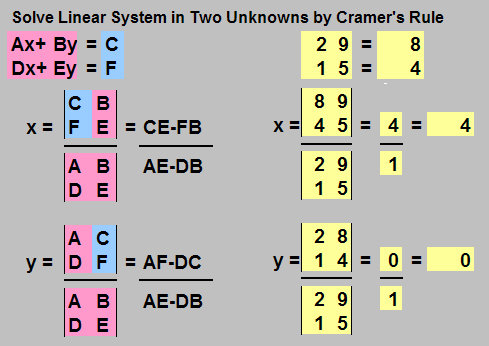| | - 1st: Arrange the equations so they look like:
-
- 2nd: Type in the values of constants and coefficients A, B, C, D, E, and F.
- Enter negatives without a space -- enter "- 2" as "-2."
-
-
-
- 3rd: Replace variables with thier values before evaluating the denominators of the solution.
-
- AE - BD is
- ()() -
()().
-
- 4th: .
AE - BD = .
-
- 5th: Determine the kind of solution the system has.
| numerator |
denominator |
fraction | system |
solution(s), sample graph |
| 0 | 0 |
0/0 is indeterminate |
dependent |
many solutions  |
| non 0 | 0 |
(non 0)/0 is
undefined |
inconsistent |
no solution  |
| non 0 | non 0 |
(non 0)/(non 0) = (solution) |
independent |
only 1 solution  |
-
- 6th: If the denominator is 0, this method won't produce a solution
- either because there isn't a solution or because there are so many solutions.
-
- If the denominator is not 0, the constant terms are required to compute the solution.
- :
:
- :
:
- Write:
-
-
-
-
-
- 7th: Reduce as needed or, if needed, declare there to be no solution or multiple solutions.
-
-
- How This Works
-
- Using
linear combination the equations for the lines are
twice added together so that first one variable is eliminated and then the other. Each time an expression
for the other variable is derived. These expressions may be used as formulas to eliminate the solving of
the system algebraically and replace the solving with the simplication of a fraction.
-
- The work is shown below.
|
| E(Ax | +By | = C) |
| -B(Dx | +Ey | = F) | |
|
|
| AEx | +BEy | = CE |
| -BDx | -BEy | = -BF |
| (AE-BD)x | +(BE-BE)y | = (CF-BF) |
| (AE-BD)x | | = (CF-BF) | |
and |
|
|
| -D(Ax | +By | = C) |
| A(Dx | +Ey | = F) | |
|
|
| -ADx | -BDy | = -CD |
| ADx | +AEy | = AF |
| (-AD+AD)x | +(-BD+AE)y | = (-CD+AF) |
| | (AE-BD)y | = (AF-CD) |
|
then |
|
-
- Cramer's Rule employs this computation in an easy format.
-
- For more on Cramer's Rule, see
cramers.xls, the spreadsheet.

 -
![[MC,i. Home]](//www.mathnstuff.com/math/spoken/here/1gif/mcihome.gif)
![[Good Stuff]](//www.mathnstuff.com/gif/goods.gif)

![[MSH! Home]](//www.mathnstuff.com/math/spoken/here/1gif/mshhome.gif)
![[Applications]](//www.mathnstuff.com/math/spoken/here/1gif/apply.gif)

![[Words]](//www.mathnstuff.com/math/spoken/here/1gif/words.gif)
![[Table]](//www.mathnstuff.com/math/spoken/here/1gif/table.gif)
![[next]](//www.mathnstuff.com/math/spoken/here/1gif/next.gif)
![[last]](//www.mathnstuff.com/math/spoken/here/1gif/last.gif) -


-
-
- ©
2008,
- A. Azzolino www.mathnstuff.com/math/algebra/asyssol.htm
|
|
